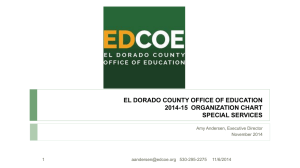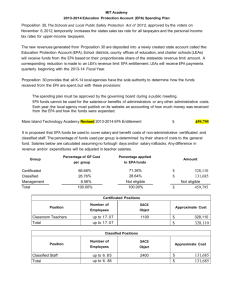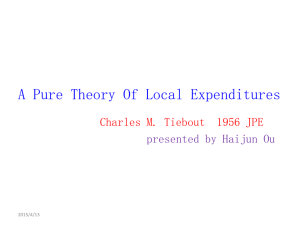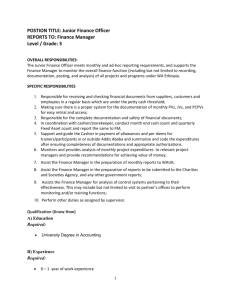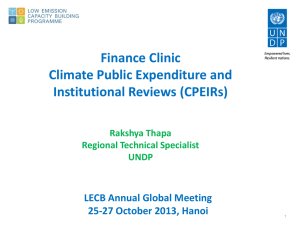Proposed Accounting Manual Sub-Coding
advertisement
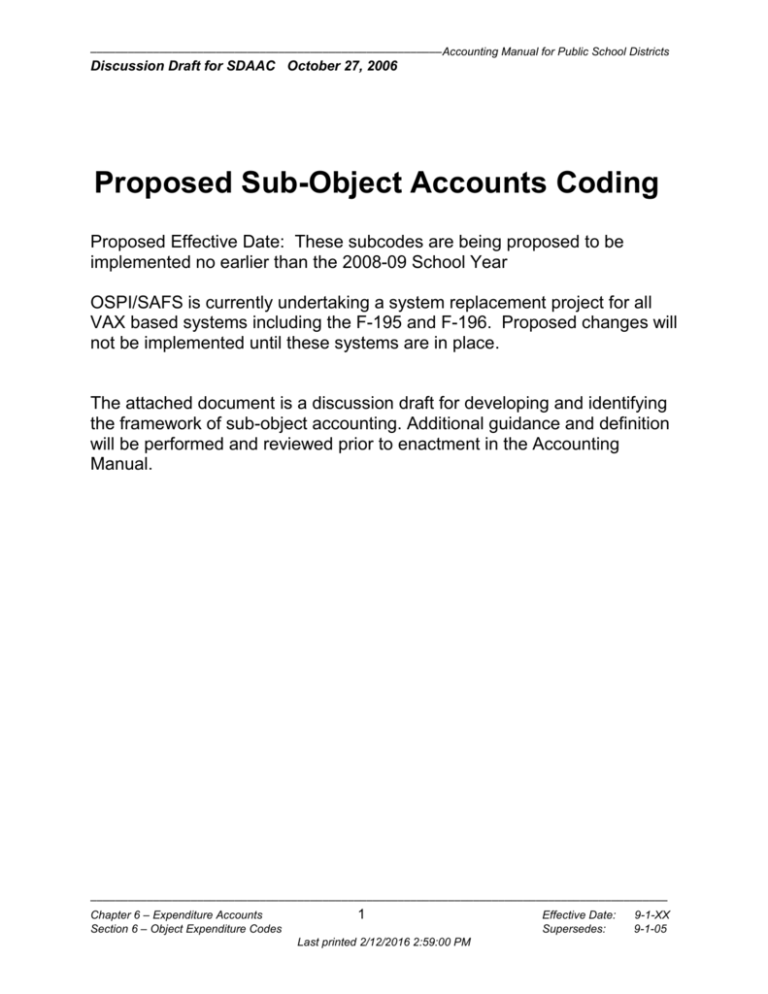
––––––––––––––––––––––––––––––––––––––––––––––––––––––––Accounting Manual for Public School Districts Discussion Draft for SDAAC October 27, 2006 Proposed Sub-Object Accounts Coding Proposed Effective Date: These subcodes are being proposed to be implemented no earlier than the 2008-09 School Year OSPI/SAFS is currently undertaking a system replacement project for all VAX based systems including the F-195 and F-196. Proposed changes will not be implemented until these systems are in place. The attached document is a discussion draft for developing and identifying the framework of sub-object accounting. Additional guidance and definition will be performed and reviewed prior to enactment in the Accounting Manual. –––––––––––––––––––––––––––––––––––––––––––––––––––––––––––––––––––––––––––––––––––––––––––– Chapter 6 – Expenditure Accounts 1 Effective Date: 9-1-XX Section 6 – Object Expenditure Codes Supersedes: 9-1-05 Last printed 2/12/2016 2:59:00 PM ––––––––––––––––––––––––––––––––––––––––––––––––––––––––Accounting Manual for Public School Districts Discussion Draft for SDAAC October 27, 2006 Object 2 Salaries—Certificated Employees This object is used to record all expenditures for salaries of certificated employees. A certificated employee means either: A person who holds a professional education certificate issued by OSPI and is one of the following: The person is employed by a district in a position for which such certificate is required by statute rule of the State Board of Education or written policy or practice of the employing district. The person is employed by an agency in a position for which such certificate is required. The person is a superintendent or is hired to fill a position designated as, or which is, in fact, deputy superintendent or assistant superintendent. Certificated employee salary expenditures include, but are not limited to: Basic teaching employment contract. Supplemental teaching or academic duty contract. Supplemental extracurricular duty contract. Additional days contract. Other special contracts for time, responsibility, or incentives. Special contract provisions such as district paid annuities, and allowance(s) such as housing or mileage/auto allowance. Retroactive, deferred or grievance-awarded pay. Optional days. Substitute pay or other temporary personnel. Miscellaneous hourly rates of pay. Annual or retirement sick leave buy-back. Vacation buy-back. Employment termination settlements. Collective bargaining settlements. NEW Object 2 Salaries—Certificated Employees - Subcodes 10 - Certificated Base Contract 20 - Certificated Additional Responsibility or Incentive 40 - Certificated Supplemental Additional Hours or Days 50 - Certificated Substitutes 60 - Certificated Leave Buyback 90 – Certificated Other –––––––––––––––––––––––––––––––––––––––––––––––––––––––––––––––––––––––––––––––––––––––––––– Chapter 6 – Expenditure Accounts 2 Effective Date: 9-1-XX Section 6 – Object Expenditure Codes Supersedes: 9-1-05 Last printed 2/12/2016 2:59:00 PM ––––––––––––––––––––––––––––––––––––––––––––––––––––––––Accounting Manual for Public School Districts Discussion Draft for SDAAC October 27, 2006 Object 3 Salaries—Classified Employees This object is used to record all expenditures for salaries of classified employees. A classified employee means any person employed by a district in a position that is not a certificated employee staff position. Classified employee salary expenditures include, but are not limited to: Pay for assigned hours per day and/or paid days per year including, but not limited to, normal workdays and holidays. Overtime. Supplemental extracurricular duty contract. Other special contracts for time, responsibility, or incentives. Special contract provisions such as district paid annuities, and allowance(s) such as housing or mileage/auto allowance. Retroactive, deferred, or grievance-awarded pay. Optional days. Substitute pay or other temporary personnel. Annual or retirement sick leave buy-back. Vacation buy-back. Employment termination settlements. Collective bargaining settlements. NEW Object 3 Salaries—Classified Employees Subcodes 10 - Classified Pay Time Driven 20 – Classified Pay Not Time Driven 50 - Classified Substitutes 60 - Classified Leave Buyback 90 – Classified Other –––––––––––––––––––––––––––––––––––––––––––––––––––––––––––––––––––––––––––––––––––––––––––– Chapter 6 – Expenditure Accounts 3 Effective Date: 9-1-XX Section 6 – Object Expenditure Codes Supersedes: 9-1-05 Last printed 2/12/2016 2:59:00 PM ––––––––––––––––––––––––––––––––––––––––––––––––––––––––Accounting Manual for Public School Districts Discussion Draft for SDAAC October 27, 2006 Object 4 Employee Benefits and Payroll Taxes This object is used to record all district paid expenditures for employee payrollgenerated benefits and employer taxes. Employee benefit and payroll tax expenditures include, but are not limited to: District portion OASI (Social Security and Medicare). State retirement systems (TRS, PERS and SERS). Unemployment insurance – L&I / Workers Compensation. Industrial insurance, medical aid, and supplemental pension contributions (workers’ compensation). Health care benefits including dental. Health Care Authority Retirement Trust Fund Subsidy. (“carve out”) Other district paid benefits NEW Object 4 Employee Benefits and Payroll Taxes - Subcodes 21 - Certificated Medical Insurance 22 - Certificated L&I / Workers Comp. 23 - Certificated Unemployment 24 - Certificated FICA 25 - Certificated Retirement 26 - Certificated Health Care Authority Retirement Subsidy 29 - Certificated Other 31 - Classified Medical Insurance 32 - Classified L&I / Workers Comp. 33 - Classified Unemployment 34 - Classified FICA 35 - Classified Retirement 36 - Classified Health Care Authority Retirement Subsidy 39 - Classified Other –––––––––––––––––––––––––––––––––––––––––––––––––––––––––––––––––––––––––––––––––––––––––––– Chapter 6 – Expenditure Accounts 4 Effective Date: 9-1-XX Section 6 – Object Expenditure Codes Supersedes: 9-1-05 Last printed 2/12/2016 2:59:00 PM ––––––––––––––––––––––––––––––––––––––––––––––––––––––––Accounting Manual for Public School Districts Discussion Draft for SDAAC October 27, 2006 Object 5 Supplies, Instructional Resources, and Noncapitalized Items This object is used to record expenditures for supplies, instructional resources, and noncapitalized items. Supplies are expendable items that are consumed in use. These items may also lose their identity through fabrication or incorporation into a different or more complex unit or structure. Supplies, instructional resources, and noncapitalized items include, but are not limited to: Accessories and parts. Bakery products. Building and hardware supplies and components. Computer supplies and software. Copy and/or duplicating supplies. Custodial supplies. Fertilizers. Food and meal preparation supplies. Glassware. Hand tools. Lumber. Office and library supplies. Paper products. Postage. Preprinted forms. Subscriptions. Transportation parts and lubricants. Non-capitalized equipment Instructional resources are those materials used to instruct students in skills or knowledge in the classroom (Activity 27 Teaching) and/or in learning resource environments (Activity 22 Learning Resources). Instructional resources include, but are not limited to: Assessment tests. Computer software. Catalogued books. Magazines and/or pamphlets. Pictures. Prerecorded audio or visual tapes/CD-ROMs. Sheet music. Subscriptions. Textbooks. Workbooks and/or kits used in lieu of workbooks. Noncapitalized items recorded here are items of equipment that are not reported under Object 9 Capital Outlay. The items must have a useful life of less than one year and/or have an acquisition cost that is less than $5,000 or the minimum capitalization value established by the school district. –––––––––––––––––––––––––––––––––––––––––––––––––––––––––––––––––––––––––––––––––––––––––––– Chapter 6 – Expenditure Accounts 5 Effective Date: 9-1-XX Section 6 – Object Expenditure Codes Supersedes: 9-1-05 Last printed 2/12/2016 2:59:00 PM ––––––––––––––––––––––––––––––––––––––––––––––––––––––––Accounting Manual for Public School Districts Discussion Draft for SDAAC October 27, 2006 Object 7 Purchased Services This object is used to record expenditures for services and associated goods from independent contractors or service providers that are rendered to the school district under expressed or implied contracts with the exception of expenditures classified as Object 8 Travel. If such expenditures increase the value or life of an asset, they should be recorded under Object 9 Capital Outlay. Independent contractors or service providers are not employees of the school district and all characteristics of the employer/employee relationship are not present in the contractual arrangement. Independent contractors or service providers provide professional services or goods and services not available from or manufactured by school district employees and they are compensated on a fee or unit price basis. Payments to independent contractors or service providers may include labor together with goods or materials and related charges furnished in the performance of such labor. When the school district and an employee purchase materials or employees of the school district perform the service, the charges will be to Object 5 Supplies and Instructional Resources, and either Object 2 Salaries—Certificated Employees or Object 3 Salaries—Classified Employees, as appropriate. (Object 4 Employee Benefits and Payroll Taxes also will be charged in either case.) Purchased services include, but are not limited to: NEW SUBOBJECT CODING ADDED 10 - Personal Contractual Services Accountants. Actuaries. Appraisers. Architects. Arbitrage Services Attorneys. Auditors. Contractors. Consultants. Labor relations. Real and personal property security. State Auditors Office 20- Utility Services Refuse and garbage. Recycling. Sewerage. 721 - Voice, data, and video telecommunications. Water and related charges. 30 - Energy Services 731 - Heating oil. –––––––––––––––––––––––––––––––––––––––––––––––––––––––––––––––––––––––––––––––––––––––––––– Chapter 6 – Expenditure Accounts 6 Effective Date: 9-1-XX Section 6 – Object Expenditure Codes Supersedes: 9-1-05 Last printed 2/12/2016 2:59:00 PM ––––––––––––––––––––––––––––––––––––––––––––––––––––––––Accounting Manual for Public School Districts Discussion Draft for SDAAC October 27, 2006 32 – Electricity. 33 - Natural gas 34 – Propane gas. 35 – Vehicle fuel 39 - Other Energy services 40 - Contract Operations and Maintenance Book repairs. Building/equipment maintenance and repairs. Cartage and shipping. Custodial. Extermination. Laundry and dry cleaning. Printing. 50 –Rental Expenditures 51 - Property rental - Expenditures for leasing or renting land and buildings for both temporary and long term use by the school district. 52 – Rental of equipment and vehicles – expenditures for leasing or renting equipment or vehicles for both temporary and long term use by the school district. (Vehicle rental related to travel would be coded under Object 8.) 60 – Student Educational Services - Payments to educational agencies for instructional services to students residing to your district, or considered to be a resident under RCW 28A.225.225. 61 – Payments to other school districts. Including Non high payments for student education and related services 62 – Payments to Educational Service District for student education and related services. 63 – Payments to in state private schools for student education and related services. 64 – Payments to out-of-state schools for student education and related services. 69 – Other payments for purchased student education services. 90 - Other Goods and Services Contracts Advertising. Arbitrage payments to IRS Bond fees, such as: Bond discount. Bond issuance expenditures. Bond transfer expenditures. Underwriting expenditures. Conference and workshop registrations. Court expenditures. Election expenditures. Fines and penalties Fingerprint/background check expenditures –––––––––––––––––––––––––––––––––––––––––––––––––––––––––––––––––––––––––––––––––––––––––––– Chapter 6 – Expenditure Accounts 7 Effective Date: 9-1-XX Section 6 – Object Expenditure Codes Supersedes: 9-1-05 Last printed 2/12/2016 2:59:00 PM ––––––––––––––––––––––––––––––––––––––––––––––––––––––––Accounting Manual for Public School Districts Discussion Draft for SDAAC October 27, 2006 Insurance. Interest, warrant and other. Membership dues. Rental of equipment, buildings, facilities, and other tangible products. –––––––––––––––––––––––––––––––––––––––––––––––––––––––––––––––––––––––––––––––––––––––––––– Chapter 6 – Expenditure Accounts 8 Effective Date: 9-1-XX Section 6 – Object Expenditure Codes Supersedes: 9-1-05 Last printed 2/12/2016 2:59:00 PM ––––––––––––––––––––––––––––––––––––––––––––––––––––––––Accounting Manual for Public School Districts Discussion Draft for SDAAC October 27, 2006 Object 8 Travel This object is used to record expenditures for travel authorized by policies of the school district. This travel may include contractual services for transporting school district employees, students, employment candidates, and representatives from place to place and the furnishing of accommodations incidental to travel and other expenditures necessitated by travel. Do not include expenditures for transporting students to and from school, instruction sites, or extracurricular activities. Travel expenditures include the following: Airplane, railroad, bus, and taxi. Automobile rental. Incidental expenditures, such as: Baggage transfer fees. Garage. Parking. Storage. Lodging and meal subsistence on an actual or per diem basis. Mileage for use of personal automobile. NEW Object 8 Travel – Subcode 10 – In state travel Link into OFM definition of in-state 20 – Out of state travel Do not include workshop or conference registration and fees within this object. These expenditures should be recorded within Object 7. –––––––––––––––––––––––––––––––––––––––––––––––––––––––––––––––––––––––––––––––––––––––––––– Chapter 6 – Expenditure Accounts 9 Effective Date: 9-1-XX Section 6 – Object Expenditure Codes Supersedes: 9-1-05 Last printed 2/12/2016 2:59:00 PM ––––––––––––––––––––––––––––––––––––––––––––––––––––––––Accounting Manual for Public School Districts Discussion Draft for SDAAC October 27, 2006 Object 9 Capital Outlay This object is used to record expenditures for capitalized equipment and improvements to buildings and/or grounds infrastructure. Capitalizable equipment is defined as a nonexpendable, tangible item of personal property having a useful life of more than one year and an acquisition cost which is the lesser of the capitalization policy established by the school district or $5,000. Included are those items composed of component items (individually not meeting the capitalization amount but which in total meet the capitalization amount). Improvements to buildings and/or grounds infrastructure are defined as those expenditures that materially increase the value or useful life of the buildings or grounds facility. Costs associated with placing the asset into operation are also includible in the purchase cost of the asset. This may include installation, testing, modification and initial training. Annual maintenance contracts are not deemed capital. Capital outlay expenditures may include, but are not limited to, the following: Air conditioner and other cooling equipment. Audio-visual equipment. Automobiles, trucks, tractors, vans, and other vehicles. Boilers, furnaces, and other heating equipment. Building and equipment major repairs and improvements. Communications equipment. Computers, printers, and other peripheral equipment. Furniture and fixtures. Instructional equipment. Lunchroom equipment. Office machines. Site improvments. NEW Object 9 Capital Outlay - Subcodes 10 – Capitalized Computer Hardware 20 – Capitalized Computer Software and initial training. 30 – Capitalized Furniture and Fixtures 40 – Capitalized Equipment 50 – Land and Buildings 60 - Vehicles 90 - Other –––––––––––––––––––––––––––––––––––––––––––––––––––––––––––––––––––––––––––––––––––––––––––– Chapter 6 – Expenditure Accounts 10 Effective Date: 9-1-XX Section 6 – Object Expenditure Codes Supersedes: 9-1-05 Last printed 2/12/2016 2:59:00 PM ––––––––––––––––––––––––––––––––––––––––––––––––––––––––Accounting Manual for Public School Districts Discussion Draft for SDAAC October 27, 2006 Proposed Activity for Professional Development The use of an Object for professional development was considered by the subcommittee. Consensus opinion was that utilization of the activity code 30 series would provide a more robust reporting, that would honor the current activity/object relationships in the current reporting structure, Activity 30 – Professional Development Activities associated with the professional development and training of district personnel. These include such activities as in-service training, seminars and conferences, continuing professional education, courses for college credit (tuition reimbursement), and other activities related to the ongoing growth and development of personnel. The incremental costs associated with providing temporary employees to perform job duties while regular employees attend training should be captured in this activity code. All costs should be charged to this code regardless of whether training services are provided internally or purchased from external vendors. Activity 31 Services supporting the development of school district certificated and classified personnel. These include such activities as in-service training, workshops, conferences, demonstrations, and other activities related to the ongoing growth and development of personnel. This activity may include course registration fees, tuition reimbursement, charges from external vendors to conduct training courses (at either school facilities or offsite), related travel and other expenditures associated with training and professional development. Note: Districts should not code base contract assignment salary here. Activity 31 should only record the substitute costs related to that assignment, if any. –––––––––––––––––––––––––––––––––––––––––––––––––––––––––––––––––––––––––––––––––––––––––––– Chapter 6 – Expenditure Accounts 11 Effective Date: 9-1-XX Section 6 – Object Expenditure Codes Supersedes: 9-1-05 Last printed 2/12/2016 2:59:00 PM
